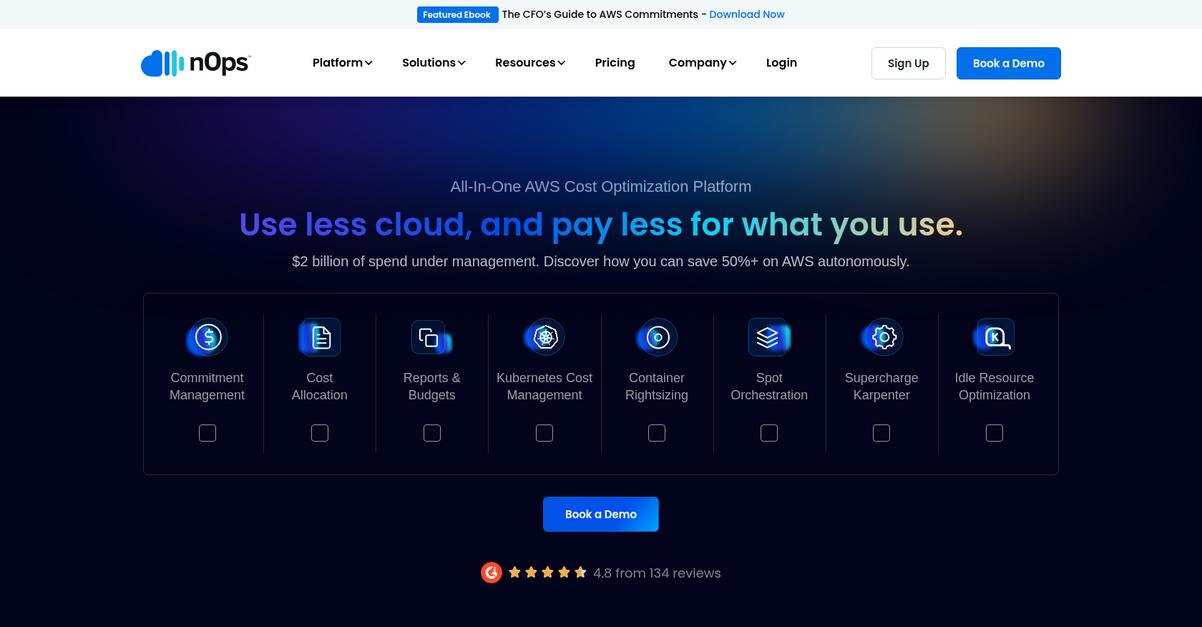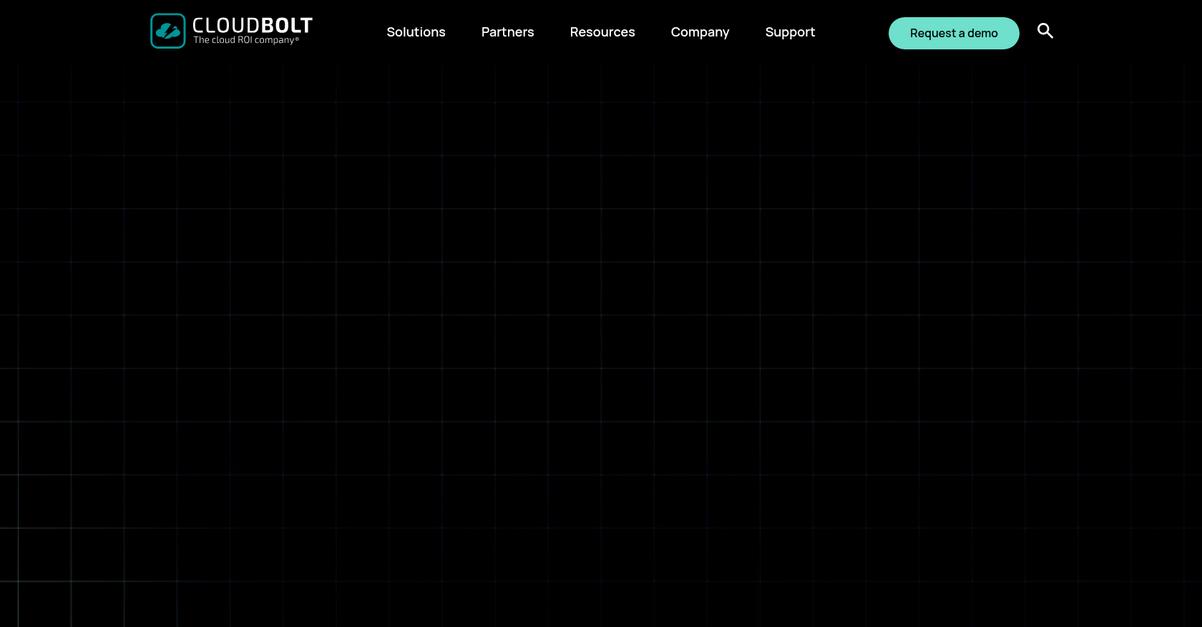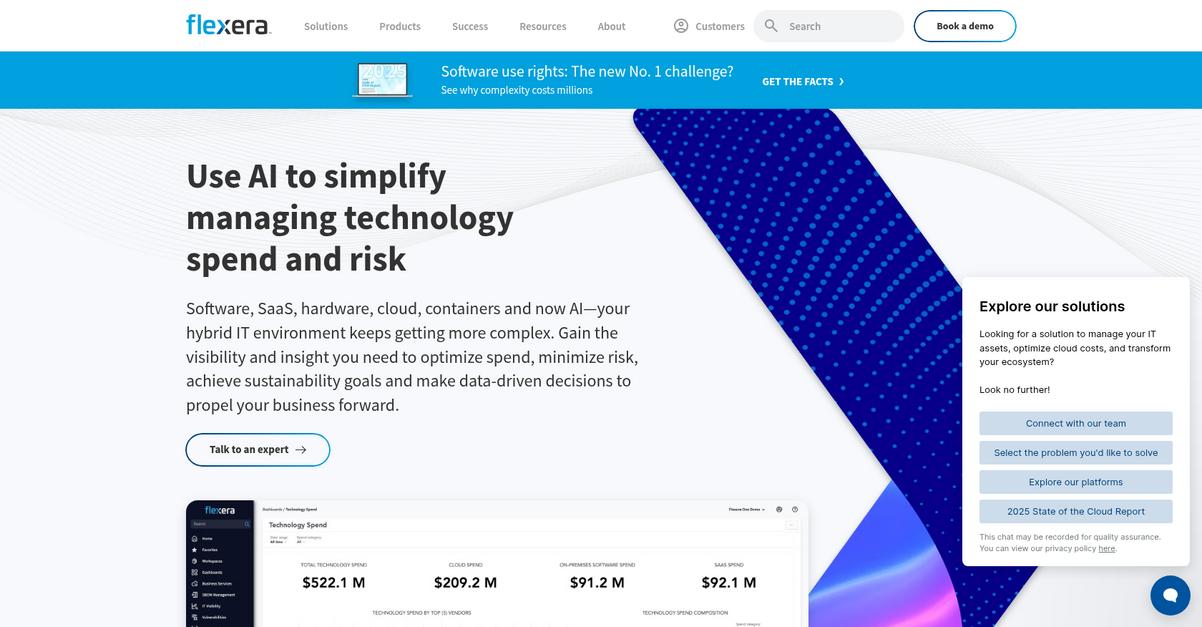Are your cloud bills out of control?
You’re juggling multiple cloud services and your budget is taking a hit. It’s tough to see where all the money is actually going.
This complexity makes it nearly impossible to justify spending to stakeholders. The real risk is wasting thousands on redundant tools and services.
And these costs only seem to be increasing. A Flexera report shows that by 2025, 33% of organizations will spend over $12 million annually on cloud services. Without a clear overview, you’re flying blind.
But what if you could change that? A unified platform gives you total visibility and cost control over your entire cloud infrastructure.
In this article, I’m guiding you through the best cloud management software. I’ll help you find a single solution to consolidate everything.
You’ll discover tools that reduce operational complexity and help you prove the ROI of your cloud investment to your leadership.
Let’s find your solution.
Quick Summary:
| # | Software | Rating | Best For |
|---|---|---|---|
| 1 | nOps → | Growth-stage companies | |
| 2 | Morpheus Data → | Enterprises with hybrid clouds | |
| 3 | CloudBolt → | IT managers & DevOps leads | |
| 4 | Flexera → | IT managers & DevOps leads | |
| 5 | Nutanix → | Companies replacing fragmented tools |
1. nOps

Struggling with cloud costs and complex management?
nOps offers an all-in-one AWS cost optimization platform to save you money. This means you can finally tackle overspending and gain control over your cloud budget.
You’re likely overpaying for unused resources and expensive on-demand compute, with 30% of cloud spend being wasted without proper controls. nOps simplifies this by intelligently managing your usage and commitments.
Here’s a better way to manage your cloud.
nOps delivers 100% cloud visibility, allowing you to see real-time costs and usage across teams and applications. This allows you to allocate all AWS, Kubernetes, GenAI, and SaaS costs, even without complete tagging.
Additionally, their ML-driven optimization continuously scales and optimizes your AWS compute and pricing across Reserved Instances, Savings Plans, and Spot instances. This includes Compute Copilot, which helps reduce EKS and ASG costs by automatically optimizing for Spot, RI, and Savings Plans. You can also maximize your Savings Plans while mitigating long-term commitment risk.
The result is autonomous cost savings, cutting cloud waste by automating time-consuming resource optimization tasks.
While we’re discussing optimizing your cloud infrastructure, understanding API security testing tools is equally important for a robust environment.
Key features:
- Total Visibility into AWS Spend: Allocate 100% of AWS, Kubernetes, GenAI, and SaaS costs, with easy filtering by customer, product, or cost center for granular insights.
- EKS & ASG Scalability and Discounts: Automatically optimize EKS and ASG environments for Spot, Reserved Instances, and Savings Plans to significantly reduce your compute expenses.
- Automated Cost Optimization Tasks: AI constantly learns your usage patterns to find and automatically turn off idle resources, delivering continuous, automated savings on your AWS bill.
nOps features, pricing, & alternatives →
Verdict: nOps is a powerful solution for organizations seeking the best cloud management software. It autonomously manages over $2 billion in annual AWS spend for innovative brands, delivering over 50% savings by providing 100% visibility, ML-driven optimization, and automated cost-saving features, making it ideal for growth-stage companies and enterprises.
2. Morpheus Data

Tired of fragmented cloud tools and vendor sprawl?
Morpheus Data unifies hybrid cloud management with a powerful self-service engine for enterprise agility, control, and efficiency.
This means you can quickly enable on-prem private clouds, centralize public cloud access, and orchestrate change with cost analytics, governance policy, and automation.
Simplify your hybrid cloud operations.
Morpheus Data introduces a single control plane to integrate hypervisors, public clouds, and Kubernetes clusters. You can provision VMs, containers, and multi-tier apps on demand, without waiting on manual IT delivery.
Finance teams can reduce cloud costs by up to 30% by improving visibility, right-sizing resources, and centralizing cost tracking for showback. The solution also empowers IT to unify their hybrid cloud, while security teams can simplify authentication and control access with consistent, approved templates.
You’ll streamline virtualization and future-proof IT with a flexible consumption model.
Achieve greater agility and cost savings.
While streamlining your cloud environment, understanding master data management software can further enhance data clarity and control.
Key features:
- Unified Hybrid Cloud Management: Consolidates control over hypervisors, public clouds, and Kubernetes clusters through a single interface, reducing tool sprawl and operational complexity for IT managers.
- Automated Application Provisioning: Empowers DevOps and platform teams to provision VMs, containers, and multi-tier applications on demand, integrating seamlessly with CI/CD pipelines to accelerate innovation.
- Granular Cost Governance: Provides comprehensive cost analytics, resource right-sizing capabilities, and centralized cost tracking to help finance teams identify and fix root causes of high cloud expenses, potentially reducing them by 30%.
Morpheus Data features, pricing, & alternatives →
Verdict: If you’re seeking the best cloud management software to unify your cloud environment, reduce costs, and enhance governance, Morpheus Data is an excellent choice. AstraZeneca, for instance, saved over $6 million and cut server build times from 80 hours to 20 minutes using this platform.
3. CloudBolt

Is your cloud ROI giving you headaches?
CloudBolt offers a robust cloud management platform and Kubernetes optimization to tackle complex cloud environments. This means you can gain control and visibility over fragmented cloud tools.
You’ll find it addresses frustrations with outdated solutions and managing multiple vendors, especially through its ability to extend FinOps beyond public cloud. It helps consolidate your costs and control.
Here’s how CloudBolt solves your cloud ROI problem.
The platform provides Augmented FinOps, allowing you to access and act upon insights across public, private, or container environments. This capability is critical for unifying cloud management.
CloudBolt helps you crush cloud waste and increase cloud ROI by enabling continuous savings through trusted automation. This includes Kubernetes cost optimization for your critical workloads. You can effectively inform and allocate resources while also optimizing and automating your cloud spending.
Additionally, it provides all the features, tools, integrations, and guardrails necessary for FinOps success, designed with ROI in mind. This means your organization can maximize cloud value, govern, and scale effectively.
The result is reduced operational complexity for your team.
Key features:
- Augmented FinOps: Extends financial operations management across public, private, and containerized cloud environments for comprehensive cost control and resource allocation.
- Kubernetes Optimization: Offers automated management and cost optimization for Kubernetes, ensuring efficient use of container resources and significant waste reduction.
- Hybrid Cloud Management: Provides a unified platform to build, manage, and optimize cloud resources across diverse hybrid cloud environments, simplifying complex operations.
CloudBolt features, pricing, & alternatives →
Verdict: If you’re an IT manager or DevOps lead seeking to reduce cloud waste by up to 99% and gain continuous savings without manual effort, CloudBolt is the best cloud management software for your needs. Its Augmented FinOps and automation capabilities empower practitioners to maximize cloud value and boost ROI.
4. Flexera

Struggling with unmanaged cloud costs and IT sprawl?
Flexera gives you complete visibility and actionable insights across your entire hybrid IT environment, from cloud to SaaS.
This means you can optimize spend, minimize risk, and even achieve sustainability goals, all while making data-driven decisions that propel your business forward with confidence.
It’s time to gain comprehensive control.
Flexera helps you unify cloud management and provide granular cost controls by shining a light on shadow IT and enabling collaborative work across your teams.
You can proactively manage software vulnerability and obsolescence risk, identify unknown assets, and streamline cloud migration initiatives. Flexera also helps eliminate wasted IT spend by identifying unused subscriptions.
Additionally, with features like spend approvals and automated governance, you get a standard approach to managing, optimizing, and scaling your cloud environment responsibly, ensuring compliance and preventing surprising bills. The result is measurably boosted ROI.
Key features:
- Comprehensive IT Visibility: Gain a complete picture of your technology everywhere it resides, including cloud, SaaS, and on-premises, enabling data-driven decisions and operational efficiency.
- Cloud Cost Governance: Manage, optimize, and scale your cloud environment responsibly with automated governance and spend approvals, mitigating the risk of unbudgeted expenses.
- FinOps Integration: Unify ITAM and FinOps to bridge visibility gaps, identify savings opportunities, and leverage AI-assisted decisions for maximizing value across your hybrid IT landscape.
Flexera features, pricing, & alternatives →
Verdict: Flexera stands out as a leading contender for the best cloud management software, offering unique capabilities that unify fragmented cloud tools. It helps identify IT waste and shadow IT, addressing key pain points for IT managers and DevOps leads seeking to reduce complexity and boost ROI by an average of 20-30% in waste reduction according to their 2024 State of ITAM Report.
5. Nutanix

Are your cloud tools causing fragmented chaos?
Nutanix offers a unified platform that integrates infrastructure and management for consistent operations. This means you can consolidate your costs and regain control.
You can replace complexity with simplicity and scalability, giving you full IT control for your applications and data. This is crucial when you’re looking to optimize cloud usage.
It’s time to unlock flexibility and control.
Nutanix helps you deploy AI fast, simplify adoption, and secure data all on one platform. This means you can achieve seamless app and data migration to the cloud without costly refactoring.
Additionally, for those dealing with virtualization vendor uncertainty, Nutanix provides a flexible, modernized platform that allows you to easily extend AI anywhere and simplify container success. This empowers your team to unify cloud management and drive innovation.
You can streamline your multi-cloud operations.
On a different note, if you’re exploring software for educational services, my guide on best tutor management software is a valuable resource.
Key features:
- Unified Platform: Consolidates infrastructure and management, enabling consistent operations for your data and applications regardless of where they reside.
- Enterprise AI Deployment: Simplifies and secures the adoption and deployment of AI, including large language models, across your entire infrastructure from edge to cloud.
- Seamless Cloud Migration: Facilitates smooth application and data migration to various cloud environments without requiring expensive and time-consuming refactoring efforts.
Nutanix features, pricing, & alternatives →
Verdict: Nutanix stands out as a leading contender for best cloud management software, especially if you’re seeking to replace fragmented tools. Its unified platform and seamless migration capabilities address critical pain points, simplifying complex operations and delivering the granular cost controls needed for modern infrastructure, as demonstrated by trusted companies like Rakuten and Wells Fargo.
6. CoreStack

Tame multi-cloud chaos and boost your security.
CoreStack offers AI-powered cloud governance with comprehensive FinOps+, SecOps, and CloudOps modules. This means you can finally unify your fragmented cloud tools and gain better visibility.
If you’re frustrated by managing multiple vendors, this platform provides a single system of intelligence for all your cloud resources.
Here’s how to simplify cloud management.
CoreStack helps you embrace the cloud with confidence, whether you use AWS, Azure, GCP, or OCI. This unified platform enhances native cloud capabilities, closing feature gaps across cost, security, operations, and compliance.
You can optimize cloud spend by detecting cost anomalies and leveraging AI to forecast usage, boosting security with real-time threat visibility and auto-remediation. Additionally, CoreStack helps you achieve continuous compliance with industry and regulatory standards like ISO/IEC and HIPAA. Plus, it streamlines operations through automation and rules-based orchestration, integrating seamlessly to drive efficiency and productivity.
The result is reduced operational complexity, enabling robust governance, and measurable ROI.
Key features:
- AI-Powered NextGen Cloud Governance: Leverages AI for intelligent insights and predictions about cloud usage, helping you reduce costs and enhance security.
- Unified Multi-Cloud Platform: Consolidates FinOps+, SecOps, CloudOps, and Assessments into a single dashboard for comprehensive management across various cloud providers.
- Continuous Compliance & Automation: Automates continuous compliance with over 27 industry standards and supports proactive security operations through auto-remediation.
CoreStack features, pricing, & alternatives →
Verdict: CoreStack provides robust AI-powered cloud governance designed to help IT managers and DevOps leads tame multi-cloud chaos. Its ability to unify FinOps+, SecOps, and CloudOps in one flexible platform makes it an excellent choice for enterprises seeking the best cloud management software to consolidate costs, boost security, and ensure continuous compliance, with one client reducing cloud costs by 20%.
7. Scalr

Struggling to unify your multi-cloud environment?
Scalr empowers platform teams to establish secure, standardized workflows, granting developers self-service capabilities. This means you can finally consolidate your fragmented cloud tools.
Scalr provides isolated environments for every team, enabling them to work independently. This dramatically reduces friction and allows your teams to focus on innovation without impacting others.
Here’s how Scalr can simplify your cloud operations.
Scalr provides flexible Role-Based Access Control (RBAC), service accounts, and pipeline observability. This ensures you maintain control while delivering autonomy, reducing the burden of constant support requests on your IT and DevOps teams.
It facilitates self-resolution of issues, enabling developers to debug themselves so you’re not constantly first-line support. Plus, Scalr provides insights to alert you when intervention is needed, allowing you to step in effectively. Additionally, Scalr supports various developer workflows, from no-code module deployments to CLI-driven Terraform or OpenTofu execution, including Atlantis-style or GitOps approaches. This flexibility means your teams can adopt their preferred methods.
The result is streamlined cloud management.
Key features:
- Self-service enablement: Create secure, standardized workflows that empower developers with self-service capabilities, reducing support overhead for platform teams.
- Isolated team environments: Provide dedicated, isolated environments for each team, ensuring independent work without impacting other projects or infrastructure.
- Workflow flexibility & hygiene: Support diverse developer workflows (CLI, no-code, GitOps) while promoting standardization, reusability, and best practices through private module registries and policy enforcement.
Scalr features, pricing, & alternatives →
Verdict: Scalr is an excellent contender for best cloud management software, designed to reduce operational complexity and boost ROI for IT managers and DevOps leads. Its focus on self-service, isolated environments, and robust workflow flexibility directly addresses pain points around fragmented tools and governance, making it ideal for growth-stage companies and enterprises aiming to unify their cloud strategy.
8. Apptio

Struggling with fragmented cloud tools and unpredictable costs?
Apptio helps you unify your cloud management by optimizing budgets and clearly communicating IT value.
This means you can transform your tech spend into business value, providing transparency on key spend drivers.
How to simplify cloud financial management?
Apptio equips IT and finance leaders with IBM Apptio Costing to manage and master technology costs, and IBM Apptio Planning to streamline budgeting and forecasting. Additionally, IBM Cloudability ingests and normalizes cloud billing data for effective spend management.
You can also leverage IBM Cloudability Savings Automation to run your commitment program on autopilot, freeing up valuable FinOps resources and delivering savings. Plus, IBM Kubecost monitors and reduces Kubernetes spend, eliminating cost surprises and maintaining performance, while Apptio Targetprocess aligns strategy and execution across the enterprise.
This provides the data-driven decisions you can truly trust.
Key features:
- Cost Management & Optimization: Transparently manage IT and cloud costs through detailed analysis and optimization of budgeting, planning, and billing processes.
- Strategic Planning & Alignment: Connect strategic goals with execution, enabling portfolio budgeting, resource management, and program management for measurable business outcomes.
- Cloud Financial Governance: Gain visibility and accountability for public cloud investments, monitor Kubernetes spend, and automate savings with commitment programs.
Apptio features, pricing, & alternatives →
Verdict: Apptio stands out as the best cloud management software for those seeking to unify operations and control costs. Its powerful suite, including IBM Apptio for IT financial management and IBM Cloudability for cloud cost optimization, empowers you to make trusted data-driven decisions. Northwell Health, for example, dramatically reduced data aggregation time, allowing more focus on spend optimization.
Conclusion
Struggling to control your cloud environment?
Choosing from dozens of platforms is overwhelming. Every vendor promises total control over spiraling costs and fragmented tools, making the decision difficult.
The cloud isn’t going away. A Tech Republic study shows Only 5% of companies plan to revert to on-premise infrastructure. This makes finding the right tool essential for your company’s future financial health.
So, what’s my top recommendation?
After extensive evaluation, I found nOps provides the clearest path to cost optimization. It gives you complete visibility to finally rein in cloud spend.
What truly sets it apart is its autonomous, ML-driven optimization for AWS. The best cloud management software should deliver savings without constant manual effort, and nOps does exactly that.
I suggest you book a free demo of nOps to see its powerful cost-saving automation in action.
You’ll gain the financial control you need.






